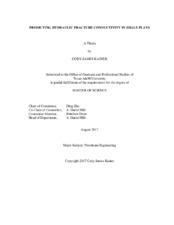| dc.description.abstract | The purpose of hydraulic fracturing in low permeability shales is to maximize surface contact area with the reservoir and create conductive flow paths for the hydrocarbons to be economically produced through. Fracture conductivity is defined as the product of fracture permeability (kf) and the width of the fracture aperture (wf). This parameter is vital as it limits the capacity of the flow path between the stimulated reservoir rock and the wellbore, for a given drawdown pressure. The resulting fracture conductivity is dependent on a plethora of rock and proppant properties. Realistic prediction of conductivity and further understanding of its relationship with rock properties would prove incredibly valuable, especially in new and developing shale plays where there is a steep initial learning curve in economic production. In this study, multiple linear regression is applied to a large database of shale conductivity experiments and a robust correlation for predicting conductivity is presented. In addition, the properties of Young’s modulus, Poisson’s ratio, compressive strength, and Brinell hardness are isolated and their effects on fracture conductivity are analyzed.
The shale plays included in the correlations are the Barnett, Fayetteville, Marcellus, and Eagle Ford shales. Brinell hardness and compressive strength were found to be highly correlated with conductivity decline as closure stress increases. Young’s modulus was also found to be a highly significant predictor of fracture conductivity in shales. A higher modulus correlated to increased conductivity at each closure stress. It was also concluded that closure stress and proppant loading conditions have a much greater influence on fracture conductivity when compared to rock mechanical properties and fracture surface characteristics. The final correlation model presented can be used to estimate fracture conductivity in various shale plays. It is important to keep in mind the distributions of the input data into the model, as well as the experimental conditions under which the conductivity was measured when applying this correlation for prediction purposes. | en |


